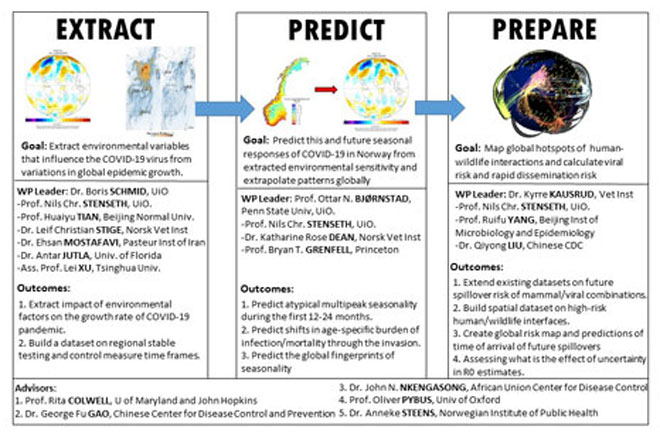About the project
Our overall aim is to carry out basic research and to apply the obtained insights to one of the biggest challenges of our time. Although we will be focusing on the spatio-temporal dynamics of COVID-19 pandemics in China, Europe and North America, much of the insight will be of profound importance to other parts of the world, not the least Africa (for which we have Dr. John N. Nkengasong as an Advisor).
Early in the project, we will produce quantitative models to forecast the seasonal conditions in Norway and other countries that favour and hinder the transmission of SARS-CoV-2, improving predictions of epidemic trends. We will continue to improve and iterate on these models throughout the project. In addition to the quantitative models, we will produce three high-quality novel datasets: (1) a dataset of the timing and spatial extent of various control measures, testing regimes and hospital patient overflows, (2) a dataset of global hotspots of human-wildlife interactions sourced from grey and published literature, and (3) a spatial database with a probabilistic assessment of the speed and intensity with which future viral spillovers are expected to arrive. We will through COVID-19 Seasonality carry out basic research and apply the obtained insights to one of the biggest challenges of our time. We expect that improved understanding of the spatio-temporal dynamics of COVID-19 pandemic will contribute profoundly to improve the preparedness against future diseases in Norway as well as globally.
Objectives
Primary objective: Develop fundamental information and inform the response to the ongoing COVID-19 pandemic. Secondary objectives:The objectives are organized into three Work Packages (WP) to (I) Extract the functional response of SARS-CoV-2 to environmental factors (including weather/seasonal variation) from variations in the growth rate of the COVID-19 pandemic; to (II) Predict the near term and long term seasonality and age-specific burden of infection of COVID-19 in Norway and other countries; and to (III) Prepare Norway (and other countries) for future pandemics by assessing the potential speed and intensity with which new emerging infectious diseases (EIDs) will arrive from geographic high-risk regions.
Outcomes
COVID-19 Seasonality will: (1) improve our knowledge of risk factors, risk areas, and conditions that facilitate this outbreak, (2) improve the advice we provide to the public, (3) slow the growth or limit the size of the outbreak, (4) leave us better prepared against future outbreaks of COVID-19 or diseases that share similar characteristics. We will do so by generating response curves of the growth rate for different meteorological factors and control measures. The modelling will inform decision making during the current crisis with regards to seasonality, age-structure and severity, and provide critical preparedness-tools against future epidemics to inform on their likely patterns of endemic circulation. We will also generate and share to the scientific community novel data sets on (1) control measures, testing regimes and hospital patient overflows, (2) global hotspots of human-wildlife interactions, and (3) probabilistic assessment of future viral spillovers
Background
The PI, Nils Chr. Stenseth, is a full-time professor at University of Oslo (extended at least through this 24-month project period) with an extensive period covering almost 50 years as an evolutionary biologist and, during the last 20 year, has worked on the ecology and evolution of disease systems. He continues to be scientifically very active and highly-cited . His work on disease started with plague, but expanded over the years to other diseases, including avian flu, hantavirus, and dengue. He was among the first in the world to model the ecology of the plague system using Soviet Union data. He is the Chair of an international Think Tank on COVID-19.
The PI and Partners form a team composed primarily of biologists with extensive backgrounds in statistical and mathematical modelling and epidemiological studies. This is an international university-based project that links up with public health institutes in Norway and China. Our various expertise are complementary, and we have pre-established and extended ongoing collaborations, facilitating the efficiency of this project. The Advisors George Fu Gao, Rita Colwell, Oliver Pybus will not be directly involved in providing or analysing data, but will provide expert feedback.
Collectively, they have rich direct experiences in working with a wide variety of infectious diseases and their involvement will ensure that the models and databases produced here are of broad relevance and are widely distributed. Anneke Steens, in her role as Research Coordinator for the COVID-19 Pandemic at the Norwegian Institute for Public Health will ensure our results can be distributed to the relevant research groups at that institute. John Nkengasong, as the Director of the Africa Centers for Disease Control and Prevention, will provide important perspective on the COVID-19 response and needs for countries in the African Union.
Financing
This project is funded by the Research Council of Norway (RCN)
RCN Project Number: 312740 (Project data bank at RCN)
UiO Project Number: 145021
Period
01.06.2020 - 30.11.2022
